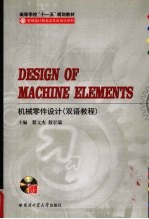图书介绍
机械零件设计 双语教程PDF|Epub|txt|kindle电子书版本网盘下载

- 翟文杰,敖宏瑞主编 著
- 出版社: 哈尔滨:哈尔滨工业大学出版社
- ISBN:7560324703
- 出版时间:2007
- 标注页数:173页
- 文件大小:8MB
- 文件页数:188页
- 主题词:机械元件-机械设计-高等学校-教材-英文
PDF下载
下载说明
机械零件设计 双语教程PDF格式电子书版下载
下载的文件为RAR压缩包。需要使用解压软件进行解压得到PDF格式图书。建议使用BT下载工具Free Download Manager进行下载,简称FDM(免费,没有广告,支持多平台)。本站资源全部打包为BT种子。所以需要使用专业的BT下载软件进行下载。如BitComet qBittorrent uTorrent等BT下载工具。迅雷目前由于本站不是热门资源。不推荐使用!后期资源热门了。安装了迅雷也可以迅雷进行下载!
(文件页数 要大于 标注页数,上中下等多册电子书除外)
注意:本站所有压缩包均有解压码: 点击下载压缩包解压工具
图书目录
Chapter 1 Introduction1
1.1 The Meaning of Design1
1.2 Design of Mechanical Systems2
1.3 Design as a Multi-Disciplinary Endeavor2
1.4 Design of Machine Elements and Role of Failure Prevention Analysis4
1.5 Fundamental Design Considerations5
Chapter 2 Fundamentals for Strength Design7
2.1 Design for Static Strength7
2.1.1 Factor of Safety8
2.1.2 Stress Concentration11
2.2 Fatigue and Cyclic Stresses13
2.2.1 Fatigue13
2.2.2 Cyclic Stress13
2.3 Design for Cyclic Loading14
2.3.1 Design for Fatigue Stress15
2.3.2 Design for Finite Life17
2.4 Failure Criteria and Modes of Mechanical Failure18
Chapter 3 Introduction to Tribology21
3.1 Friction21
3.2 Wear22
3.2.1 Adhesive Wear22
3.2.2 Abrasive Wear23
3.2.3 Fatigue Wear23
3.3 Lubrication24
Chapter 4 Power Transmission Shafting,Couplings,Keys and Splines26
4.1 Uses and Characteristics of Shafting26
4.2 Potential Failure Modes27
4.3 Shaft Materials28
4.4 Design for Static Loads29
4.5 Reversed Bending and Steady Torsion30
4.6 Shaft Design Procedure30
4.7 Couplings,Keys,and Splines33
4.7.1 Couplings33
4.7.2 Keys and Splines37
Chapter 5 Sliding Bearings42
5.1 Types of Bearings42
5.2 Uses and Characteristics of Sliding Bearings42
5.3 Potential Failure Modes43
5.4 Sliding Bearing Materials44
5.5 Boundary-Lubricated Bearing Design44
5.6 Hydrodynamic Bearing Design46
5.6.1 Lubricant Properties46
5.6.2 Petroff’s Friction Analysis48
5.6.3 Hydrodynamic Lubrication Theory—Reynolds Equation49
5.6.4 Design Considerations in Hydrodynamic Journal Bearings50
5.6.5 Bearing Performance—An Evaluation Example52
5.6.6 Optimization Techniques58
Chapter 6 Rolling Element Bearings60
6.1 Characteristics of Rolling Element Bearings60
6.2 Types of Rolling Element Bearings61
6.3 Potential Failure Modes63
6.4 Bearing Materials64
6.5 Bearing Selection64
6.5.1 Basic Load Ratings65
6.5.2 Reliability Specifications66
6.5.3 Suggested Selection Procedure for Steady Loads66
6.6 Mounting and Enclosure69
6.6.1 Mounting69
6.6.2 Preloading71
6.6.3 Alignment72
6.6.4 Enclosures72
Chapter 7 Power Screw Assemblies76
7.1 Uses and Characteristics of Power Screws76
7.2 Potential Failure Modes78
7.3 Materials78
7.4 The Mechanics of Power Screws79
7.5 Suggested Power Screw Design Procedure82
Chapter 8 Threaded Joints84
8.1 Selection of Joint Type and Fastening Method84
8.2 Threaded Fasteners85
8.3 Screw Thread Standards and Terminology86
8.4 Strength under Static Load89
8.4.1 Joints Designed without Initial Stress90
8.4.2 Joints Designed for Axially Loaded Threaded Parts91
8.4.3 Joints Designed with Initial Stress91
8.4.4 Joints Designed for Shear-Loaded Threaded Parts95
8.5 Load Distribution between Threaded Parts in a Group Joint96
8.6 Tightening and Locking97
8.6.1 Tightening Torque97
8.6.2 Locking Methods98
Chapter 9 Springs100
9.1 Types and Characteristics of Springs100
9.2 Potential Failure Modes101
9.3 Spring Materials102
9.4 Axially Loaded Helical-Coil Springs;Stress103
9.5 Deflection and Spring Rate106
9.6 Buckling Analysis of Helical Compression Springs108
9.7 Procedure and General Guidelines for Spring Design109
Chapter 10 Gears112
10.1 Types of Gears112
10.2 Potential Failure Modes114
10.3 Gear Materials and Heat Treatment116
10.4 Force Analysis for Spur Gears117
10.5 Stress Analysis and Design for Spur Gears118
10.5.1 Calculation of Teeth Surface Strength for Spur Gears118
10.5.2 Calculation of Teeth Bending Strength for Spur Gears124
10.6 Designing of Helical Gears130
10.6.1 Load Analysis for Helical Gears130
10.6.2 Calculation of Teeth Surface Strength for Helical Gears131
10.6.3 Calculation of Teeth Bending Strength for Helical Gears131
10.7 Summary of Gear Design132
10.7.1 Suggested Design Procedure132
10.7.2 Some Consideration in the Design of Gears132
10.8 Structural Design of Pinions and Gears133
10.9 Lubrication135
Chapter 11 Worm Gears136
11.1 Worm Gears and Worms;Nomenclature,Materials136
11.2 Main Parameters and Geometrical Calculations137
11.3 Force Analysis140
11.4 Stress Analysis and Design141
11.5 Structural Design of Worm and Gears143
11.6 Lubrication and Heat Dissipation144
11.6.1 Efficiency of Wormset144
11.6.2 Lubrication and Heat Dissipation145
Chapter 12 Brakes and Clutches147
12.1 Types of Brakes and Clutches147
12.2 Potential Failure Modes and Materials Selection148
12.3 Basic Concepts for Design of Brakes and Clutches149
12.4 Band Brakes150
12.5 Disk Brakes and Clutches152
Chapter 13 Belt Drives155
13.1 Characteristics of Belt Drives155
13.2 Potential Failure and Belt Materials156
13.3 Flat Belts157
13.4 V-Belts159
13.5 Synchronous Belts166
Appendix168
References173